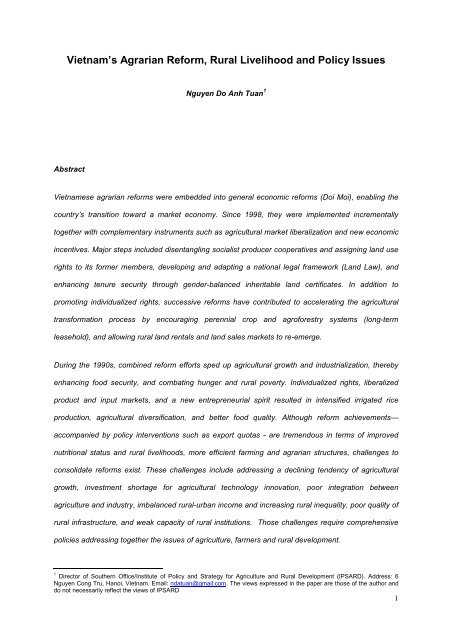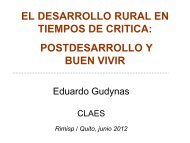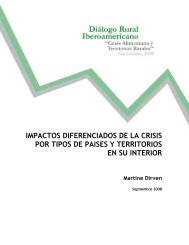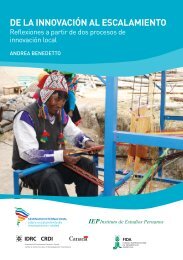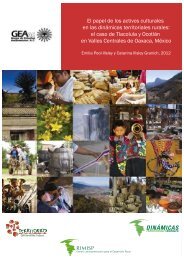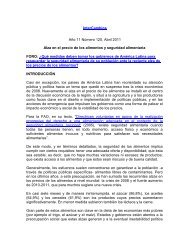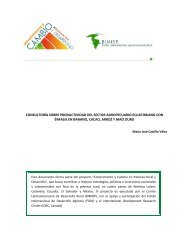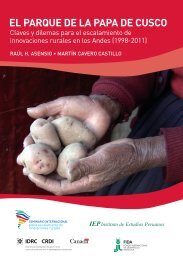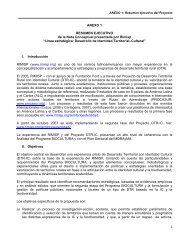Vietnam's Agrarian Reform, Rural Livelihood and Policy ... - Rimisp
Vietnam's Agrarian Reform, Rural Livelihood and Policy ... - Rimisp
Vietnam's Agrarian Reform, Rural Livelihood and Policy ... - Rimisp
You also want an ePaper? Increase the reach of your titles
YUMPU automatically turns print PDFs into web optimized ePapers that Google loves.
Vietnam’s <strong>Agrarian</strong> <strong>Reform</strong>, <strong>Rural</strong> <strong>Livelihood</strong> <strong>and</strong> <strong>Policy</strong> IssuesNguyen Do Anh Tuan 1AbstractVietnamese agrarian reforms were embedded into general economic reforms (Doi Moi), enabling thecountry’s transition toward a market economy. Since 1998, they were implemented incrementallytogether with complementary instruments such as agricultural market liberalization <strong>and</strong> new economicincentives. Major steps included disentangling socialist producer cooperatives <strong>and</strong> assigning l<strong>and</strong> userights to its former members, developing <strong>and</strong> adapting a national legal framework (L<strong>and</strong> Law), <strong>and</strong>enhancing tenure security through gender-balanced inheritable l<strong>and</strong> certificates. In addition topromoting individualized rights, successive reforms have contributed to accelerating the agriculturaltransformation process by encouraging perennial crop <strong>and</strong> agroforestry systems (long-termleasehold), <strong>and</strong> allowing rural l<strong>and</strong> rentals <strong>and</strong> l<strong>and</strong> sales markets to re-emerge.During the 1990s, combined reform efforts sped up agricultural growth <strong>and</strong> industrialization, therebyenhancing food security, <strong>and</strong> combating hunger <strong>and</strong> rural poverty. Individualized rights, liberalizedproduct <strong>and</strong> input markets, <strong>and</strong> a new entrepreneurial spirit resulted in intensified irrigated riceproduction, agricultural diversification, <strong>and</strong> better food quality. Although reform achievements—accompanied by policy interventions such as export quotas - are tremendous in terms of improvednutritional status <strong>and</strong> rural livelihoods, more efficient farming <strong>and</strong> agrarian structures, challenges toconsolidate reforms exist. These challenges include addressing a declining tendency of agriculturalgrowth, investment shortage for agricultural technology innovation, poor integration betweenagriculture <strong>and</strong> industry, imbalanced rural-urban income <strong>and</strong> increasing rural inequality, poor quality ofrural infrastructure, <strong>and</strong> weak capacity of rural institutions. Those challenges require comprehensivepolicies addressing together the issues of agriculture, farmers <strong>and</strong> rural development.1 Director of Southern Office/Institute of <strong>Policy</strong> <strong>and</strong> Strategy for Agriculture <strong>and</strong> <strong>Rural</strong> Development (IPSARD). Address: 6Nguyen Cong Tru, Hanoi, Vietnam. Email: ndatuan@gmail.com. The views expressed in the paper are those of the author <strong>and</strong>do not necessarily reflect the views of IPSARD1
1. <strong>Agrarian</strong> <strong>Reform</strong> Process in VietnamBy the mid-1980s, it became painfully clear that Vietnam’s system of collective agriculture was notworking. In 1987, after several years of slow growth, food production actually declined by 4.4 percent<strong>and</strong> famine struck parts of the country. Making matters worse, inflation had risen from 92 percent in1985 to 775 percent in 1986, making food more <strong>and</strong> more expensive for the country’s population of 60million.At the Sixth National Party Congress in December 1986, the Vietnamese Communist Party enacted aseries of reforms that would ultimately transform Vietnam from a centrally planned economy to amarket-oriented one. The reform process, known as Doi Moi, did not really take hold until 1988, butonce the collectives were dismantled, l<strong>and</strong>-use rights were assigned to farmers, agricultural marketswere liberalized, <strong>and</strong> wider economic reforms were implemented. As a result, Vietnam’s economy tookoff. For about a decade starting in the early 1990s, the country’s gross domestic product (GDP) grewat an annual rate of 7.6 percent thanks in large part to the rapid increase in agricultural growth, whichgrew 4.9 percent annually between 1996 <strong>and</strong> 2000, when the growth rate reached an all-time high(Minot et al., 2006; Sephri <strong>and</strong> Akram-Lodhi, 2002).The reforms unleashed a new entrepreneurial spirit in Vietnam, both in agriculture <strong>and</strong> in othersectors. Farmers intensified rice production, diversified into new crops such as coffee <strong>and</strong> cashews,<strong>and</strong> improved the quality of the food they produced. By stimulating agricultural <strong>and</strong> overall economicgrowth, the reforms helped reduce rural poverty, hunger, <strong>and</strong> malnutrition. In just five years—from1993 to 1998—the share of people living in poverty fell by 21 percent. Among children younger thanfive, the rate of stunting—meaning a low height for age, a symptom of poor nutrition—declined from 53to 33 percent during the same period (Fritzen, 2002).1.1. Collective Agriculture in Vietnam: 1954-1988When Vietnam achieved independence from France in 1954, the Geneva Accords divided it into twocountries with opposing ideologies—the Democratic Republic of Vietnam in the north adopted asocialist ideology influenced by China <strong>and</strong> the Soviet Union, <strong>and</strong> the Republic of Vietnam in the southpursued a capitalist ideology influenced by the United States. Civil war soon followed.2
The rural economies of the two countries were very different. In North Vietnam’s collectivizedagriculture, groups of households formed production brigades, which were responsible for meetinggovernment quotas for agricultural production. In South Vietnam, agriculture was highlycommercialized <strong>and</strong> more oriented to the export market, <strong>and</strong> tenant farmers or sharecropperscultivated l<strong>and</strong> owned by l<strong>and</strong>lords (Do <strong>and</strong> Iyer, 2003; Watts, 1998).Following reunification in 1975, the Vietnamese Communist Party attempted to extend its centrallyplanned system—in particular, its large-scale agricultural collectivization—to the whole country. In thesouth, however, collectivization did not take hold. By 1980, only 24.5 percent of farm householdsbelonged to a collective, <strong>and</strong> in many cases, southern farms were collectives on paper only (Kerkvliet,1995; Nguyen, T.M, 1995).Moreover, collective agriculture was performing poorly. In 1976 <strong>and</strong> 1977, agricultural productioncontracted by 0.5 percent <strong>and</strong> 6.6 percent, respectively. The amount of grain available in the countrywas falling, forcing the government to increase grain imports sharply. Government procurement offood also dropped, as farmers sought to avoid the state procurement system <strong>and</strong> instead sold theiroutput through informal private markets, where prices were reported to be 10 times higher (Akram-Lodhi, 2001; Chu, V.L. et al., 1992; Fforde <strong>and</strong> de Vylder, 1996; Nguyen, D.A.T., 2006).By the early 1980s, Vietnam faced an economic crisis. Western <strong>and</strong> Chinese aid to the country wasdeclining, government food procurements were falling, <strong>and</strong> a food crisis was emerging. The unpopularsystem of collective agriculture was on the verge of spontaneous breakdown (Fforde <strong>and</strong> de Vylder,1996; Lang, 1985). The Vietnamese Communist Party responded by issuing Directive 100 on January13, 1981. This directive allowed collectives to contract with individual households to produce a certainamount of agricultural goods <strong>and</strong> then sell any surplus they produced in the private market or to statetrading agencies. In mid-1981, procurement prices of agricultural goods were increased to the samelevel as market prices.At first, this partial reform seemed promising—agricultural growth reached 10.6 percent in 1982.Success, however, was short-lived. The reforms, designed to make collective agriculture moreefficient, were not deep enough to give farmers real incentives to produce more. Agricultural growthstarted to slow in 1983 <strong>and</strong> became negative by 1987. Inflation rose sharply, reaching 775 percent in3
1986. The gap between free market <strong>and</strong> official prices was 10 times or more. Per capita foodproduction fell below the minimum needed level of 300 kilograms a year. People were going hungryagain (Beresford <strong>and</strong> Fforde, 1996; Nguyen K.V., 1990; Nguyen, D.A.T, 2006).1.2. <strong>Agrarian</strong> <strong>Reform</strong>: 1988-2000Under the Doi Moi reform process adopted in December 1986, the collective agriculture system beganto be dismantled. The reforms had sweeping goals: they sought to stabilize the economy, develop theprivate sector, increase <strong>and</strong> stabilize agricultural output, shift the focus of investment from heavy tolight industry, focus on export-led growth, <strong>and</strong> attract foreign investment.It was not until 1988, however, that the Communist Party issued Resolution 10, which shifted the focusof rural development from collectives to household production. Resolution 10 obliged the agriculturalcollectives to contract l<strong>and</strong> to households for 15 years for annual crops <strong>and</strong> 40 years for perennialcrops. Households were allowed to buy <strong>and</strong> sell animals, equipment, <strong>and</strong> machinery. They still had tomeet production quotas, but the production amounts <strong>and</strong> prices were fixed for five years, givinghouseholds a degree of certainty that they had previously lacked. The private sector was allowed toengage in food marketing.Further reforms followed. From 1987 to 1991, the government relinquished control over prices <strong>and</strong>opened markets for both domestic <strong>and</strong> international trade. In 1989, it sharply devalued the country’scurrency, making Vietnamese exports much more competitive on international markets (Fforde <strong>and</strong> deVylder, 1996; Sepehri <strong>and</strong> Akram-Lodhi, 2002).The reforms unleashed a surge of entrepreneurship <strong>and</strong> productivity. Agricultural growth jumped,reaching 3.8 percent a year from 1989 to 1992. As the government retreated from controlling markets<strong>and</strong> prices, farm households had new incentives to produce more <strong>and</strong> sell their surpluses. Vietnam,which had imported more than 460,000 tons of food in 1987 <strong>and</strong> again in 1988 to meet shortfalls innational production, became the world’s third-largest exporter of rice in 1989, alleviating national foodshortages <strong>and</strong> generating large amounts of foreign exchange for the country (Dang, K.S. et al. 2005;Nguyen, D.A.T, 2006).4
Success in agriculture became a key driver of overall economic growth. Inflation plummeted to 36percent in 1989. Growth in the agricultural sector in turn increased dem<strong>and</strong> for construction <strong>and</strong>services. Although Vietnam experienced cuts in foreign aid owing to the collapse of the EasternEuropean socialist system during 1990–91, economic growth in the country remained strong. By 1992,Vietnam had fully recovered from the shock caused by the collapse of the socialist system, <strong>and</strong> theeconomy’s growth rate climbed to 8.7 percent (Dollar, 1994).Still, it was difficult for farmers to grow commercial crops such as coffee, rubber, cashew nut, <strong>and</strong>pepper, in large part because they still did not have complete, long-term rights to their l<strong>and</strong>. Financialinstitutions refused to accept existing l<strong>and</strong>-use rights as collateral, preventing households fromacquiring loan funds for agricultural investment. And local governments still played a dominant role indeciding crop patterns for specific types of l<strong>and</strong>, requiring most l<strong>and</strong> to be used for food production<strong>and</strong> discouraging agricultural diversification <strong>and</strong> further commercialization. In addition, many ruralhouseholds, especially poor <strong>and</strong> smallholding ones, had difficulty obtaining access to productiontechnologies, inputs, <strong>and</strong> capital for production (Akram-Lodhi, 2001; Fforde <strong>and</strong> de Vylder, 1996). In1993, Vietnam passed a L<strong>and</strong> Law that extended l<strong>and</strong> tenure to 20 years for annual crops <strong>and</strong> 50years for perennial crops such as coffee <strong>and</strong> rubber.The period from 1993 to 2000 was the “golden age” of the market economy in Vietnam. Theagricultural sector grew at 4.6 percent annually, <strong>and</strong> the nonagricultural sector grew by more than 8percent, thanks in large part to heavy foreign investment in Vietnamese industries. Even during theAsian financial crisis during 1997–2001, Vietnam maintained strong economic performance <strong>and</strong> theagricultural growth averaged 3.9 percent per year (Sepehri <strong>and</strong> Akram-Lodhi, 2002; Nguyen, D.A.T,2006).1.3. Key Factors, Interactions <strong>and</strong> OutcomesL<strong>and</strong> reform <strong>and</strong> decollectivization in Vietnam have been implemented as part of the state’s generaleconomic reforms (Doi Moi). This reform process must be seen in the context of historical events thatled to the division of the country in 1954, the Vietnam War, its reunification, <strong>and</strong> the collectivization ofthe whole country in the 1970s. After the war, weaknesses in the collective system became obvious.The economic <strong>and</strong> food crisis in the late 1970s led the Communist party to reconsider its economic5
development models <strong>and</strong> it provided more incentives to individuals. The main purpose was to increasethe efficiency of the socialist system rather than adopt a market system.The momentum of partial economic reform was further strengthened by the Soviet perestroika <strong>and</strong> theeconomic crisis in the mid-1980s. The salient events during this period were the relocation of l<strong>and</strong> tofarmers’ households, decollectivization in 1988, <strong>and</strong> a series of market liberalization policies from thelate 1980s onward. This process was gradual–not a big bang approach.The second half of the 1990s witnessed the golden age of Vietnam’s economic growth with reforms inthe regulatory <strong>and</strong> institutional framework of commodity <strong>and</strong> labor markets, <strong>and</strong> intensifiedinternational integration. This reform <strong>and</strong> growth period ended with the Asian financial crisis, leadingthe government to hesitate on providing further reform.<strong>Agrarian</strong> reform can therefore not be separated from the overall Doi Moi in Vietnam, <strong>and</strong> it isnecessary to add a stronger policy perspective to the common underst<strong>and</strong>ing of the reform process,which is characterized as bottom-up, path-dependent <strong>and</strong> crisis-driven (van Brabant, 1990; Fforde <strong>and</strong>de Vylder, 1996). Active policy measures along with market liberalization <strong>and</strong> international integration,which not only generated innovative ideas but also consolidated the reform process’ performance <strong>and</strong>outcomes, have become more important. In agriculture, l<strong>and</strong> tenure reform <strong>and</strong> decollectivizationstarted first at peasant households <strong>and</strong> local authorities implemented them in the 1960s <strong>and</strong> 1970swithin the collective system. Though keeping strictly to the socialist ideologies <strong>and</strong> centrally planning,the state, under severe economic shortages, gradually accepted individual interests <strong>and</strong> formallyillegal contract practices. When the upcoming food crisis threatened the survival of the centralplanning <strong>and</strong> collective system, the political leadership actively reviewed those local experiments <strong>and</strong>scaled them up into national policies.In the 1990s, market liberalization was chosen to speed up economic growth <strong>and</strong> industrialization aftera long period of hunger, poverty, <strong>and</strong> international isolation. Under this pressure, the state played amore active role in consolidating reform results <strong>and</strong> looking for new options. However, reform efforts inthe 1990s focused more on nonagricultural sectors, as agriculture <strong>and</strong> rural development were stillbenefiting from the momentum brought about by the drastic reform of Resolution 10 in 1988.6
1.4. Impacts of the <strong>Agrarian</strong> <strong>Reform</strong> on Farmer <strong>Livelihood</strong>Since the late 1980s, Vietnam’s economic reforms have generated powerful incentives to invest inagriculture. Agricultural growth peaked at an average of 4.9 percent per year during 1996–2000(Figure 1), <strong>and</strong> this has been the foundation of the economic reform in Vietnam. Though agriculturalshare in total GDP has been declining, the sector has always been the foundation for the developmentof industry <strong>and</strong> service sectors in Vietnam.Figure 1. GDP Growth by Sector since the Economic <strong>Reform</strong> in Vietnam161412108%6420-21986198719881989199019911992199319941995199619971998199920002001200220032004200520062007-4Total Agriculture Industry ServiceSource: General Statistics Office of Vietnam, various years.As a result of rapid agricultural growth, Vietnam has been able to shift from a subsistence-basedeconomy to one of sound food security <strong>and</strong> become a strong exporter of agricultural products. Thishas laid a solid foundation for the smooth transition from a centrally planned economy to a marketeconomy which is one of the critical changes that many of the former socialist countries in EasternEurope <strong>and</strong> the USSR have failed to achieve. A fast pace of production growth over a rather longperiod has also created a pre-requisite for agriculture to support industrialization process. Particularly,food surplus has helped to keep low cost of living <strong>and</strong> correspondingly low real wage for labortransferred from agriculture to non-agricultural sector (Dang, K.S., 2009; Nguyen, D.A.T, 2006). On theother h<strong>and</strong>, the increase in per capita rice production provided people with enough to eat, thusincreasing national food security. Later on, the growth of food production played an important role in7
stabilizing food prices, increasing real wages, <strong>and</strong> creating opportunities for farmers to participate inmore profitable, higher-value farming <strong>and</strong> nonfarm activities (Minot <strong>and</strong> Goletti, 2000).<strong>Reform</strong>s have led to greater food security <strong>and</strong> better nutrition, partly by increasing the production ofrice, by far the most important staple food in the Vietnamese diet. Rice is consumed by 99.9 percent ofVietnamese households <strong>and</strong> accounts for about 75 percent of the total caloric intake of a typicalhousehold. From 1980 to 1984, farmers saw their rice yields rise by about 32 percent in the North <strong>and</strong>24 percent in the South as a result of Directive 100 <strong>and</strong> subsequent complementary reforms, followedby similar gains as rice yields increased from 3.2 to 4.9 tons per hectare between 1990 <strong>and</strong> 2006, as aresult of Resolution 10 <strong>and</strong> other policy <strong>and</strong> economic changes (Pingali <strong>and</strong> Vo T.X, 1992).Increased food production <strong>and</strong> higher incomes have led to more diversified diets, with measurablebenefits for nutrition. Between 1993 <strong>and</strong> 1998, the rates of underweight in children younger than agefive fell slowly, but rates of stunting in children dropped dramatically, from 53 to 33 percent (Fritzen,2002). The economic changes launched by the Doi Moi reforms also pulled many Vietnamese out ofpoverty. From 1993 to 2002, the incidence of poverty in Vietnam fell from 58 to 29 percent (WorldBank, 2003). The number of people living in absolute poverty (however it is defined) is still high, butthe poverty that persists today reflects the fact that some households still have poor access to l<strong>and</strong> orhave access only to poor-quality l<strong>and</strong>.During the 1990s, rice prices increased substantially. Nearly three-quarters of Vietnamese householdsboth produced <strong>and</strong> consumed rice, but households that produced more rice than they consumedbenefited from the higher prices. On average, higher rice prices thus helped households in rural areas,where most of the poor live, at the expense of households in urban areas (Minot <strong>and</strong> Goletti, 2000).2. <strong>Policy</strong> Issues for Vietnam’s Agriculture <strong>and</strong> <strong>Rural</strong> Development in the NewMillenniumSince 2001, Vietnam’s agricultural growth has been continuing at 3.7 percent per annum despite adifficult external environment of low commodity prices on world markets. Food per capita increasedfrom 420 kg in 2001 to 470 kg in 2007, ensuring national food security <strong>and</strong> enabling more than 48
million tons of rice export every year. Agricultural diversification <strong>and</strong> commercialization aggressivelytook place. Many cash crops such as coffee, rubber, black pepper, <strong>and</strong> cashew nut have graduallyoccupied important positions in the international market. The export turnover of agricultural, forestry,<strong>and</strong> fishery products during the period of 2001–07 was $US49.6 billion, gaining an annual growth of16.8 percent. Vietnam has become the second largest coffee exporter <strong>and</strong> the first largest exporter ofRobusta coffee since 2000. Within a decade from 1995, coffee production increased by three times,<strong>and</strong> Vietnam gained more than US$1 billion from coffee exports in 2007. Similarly, Vietnam hasbecome the biggest exporter of cashew nut <strong>and</strong> pepper, accounting for more than 50 percent of worldexports since 2003–04.Figure 2. GDP Growth Index in the Agricultural Sector 1985 -2006 (1985=1)Source: General Statistics Office of Vietnam, various years.In the new millennium, benefits from high economic growth again established a sound base for thestate to reconsider its new urban-bias development strategies. Declining agricultural growth, wideningrural–urban income gaps, <strong>and</strong> decreasing rural social stability became major factors contributing to thenew tendency toward balancing intersectoral growth <strong>and</strong> integrating agricultural <strong>and</strong> rural developmentinto the high-speed process of industrialization, modernization, <strong>and</strong> international integration (WorldBank, 2008; Dang K.S., 2009).9
2. 1. Declining Agricultural Growth <strong>and</strong> Low EfficiencyThough agricultural growth has been high after the economic reform, its sustainability <strong>and</strong> efficiency isbeing under big questions. The growth of agriculture in Viet Nam over the last 20 years was the resultof a combination of institutional factors such as new incentives to farmers recognized by Doi Moi asautonomous economic agents <strong>and</strong> physical factors such as l<strong>and</strong>, labor, capital (mostly in the form ofirrigation system), <strong>and</strong> intermediate inputs such as fertilizer.Table 1. Agricultural Growth Accounting Estimation in Vietnam, 1986–2005Period Ag. GDP Labor Tractor Pump Fertilizer Area ofAnnualCropGrowth (percent)Area ofPerennialCrop1986–902.7 2.5 -4.7 -1.2 -3.4 0.8 5.41991–954.7 6.9 28.6 25.6 13.4 2.0 7.81996–20004.9 1.3 10.5 10.3 4.0 2.7 9.82001–20053.7 1.0 5.7 4.4 1.4 1.0 3.01986–20053.8 2.7 10.5 9.8 8.0 1.7 6.3Factors contributing to growth, based on their elasticities (percent)1986–902.7 0.8 -0.2 -0.1 -0.5 0.3 0.2 2.01991–954.7 2.2 0.9 1.4 1.8 0.8 0.4 -2.81996–20004.9 0.4 0.3 0.6 0.5 1.1 0.4 1.52001–20053.7 0.3 0.2 0.2 0.2 0.4 0.1 2.21986–20053.8 0.9 0.3 0.5 1.1 0.7 0.3 0.0Percent of factors contributing to 1 percent agricultural growth1986–90100.0 29.9 -5.9 -2.4 -17.1 12.4 9.2 73.91991–95100.0 47.5 19.9 29.4 37.9 17.6 7.4 -59.71996–2000100.0 8.9 7.0 11.4 10.9 22.3 9.1 30.32001–2005100.0 8.5 5.1 6.5 5.2 11.4 3.7 59.51986–2005100.0 23.2 9.1 14.0 28.3 18.2 7.5 -0.3Elasticities (percent)32.5 3.3 5.4 13.4 40.9 4.5Note: TFP is the residual of agricultural growth minus sum of factor growth weighted by elasticities.Source: Nguyen, D.A.T. 2008.TFPOver the 20 years of Doi Moi, investment in agricultural inputs (best illustrated by volume of fertilizers)<strong>and</strong> labor has played the most important role, contributing 23.2 <strong>and</strong> 28.3 percent respectively to theoverall growth of agriculture. Increased acreage of crops has brought about 25 percent of the growthof the sector (see Table 1), which has been significantly enhaced by large investment in irrigationsystem by the government.Yet, the growth accounting framework shows that technology innovation made just modestcontribution to agricultural growth. Role of investment in production modernization (indicated by the10
increase in number of machinery) <strong>and</strong> science-technology development (indicated by growth of totalfactor productivity - TFP) has not been very significant in contributing to agricultural growth over thelast 20 years (9.1 percent from tractors, 14 percent from pumps <strong>and</strong> -0.3 percent from TFP). Thisshows that the contribution of mechanization, labor productivity <strong>and</strong> product quality to agriculturalgrowth remains very limited.Figure 3. Mean Technical Efficiency Change, Technical Change <strong>and</strong> Total Factor Productivity(TFP) Change in Agriculture, 1980-20000.120.10.080.060.040.02Technical changeEfficiency change0-0.02-0.04ChinaAustraliaVietnamMyanmarIndiaPhillipinesMalaysiaThail<strong>and</strong>IndonesiaSource: Coelli <strong>and</strong> Rao (2003), adopted from Spielman <strong>and</strong> Kelemework (2008)Figure 3 adopted from Coellie <strong>and</strong> Rao (2003) bolsters the above arguments by showing factorscontributing to TFP growth during 1980-2000 in selected countries. Compared to other countries, TFPgrowth of Vietnam’s agriculture is at medium level, but this is totally contributed by efficiency changerather than technical change (recorded as negative). This reflect the nature of TFP growth inVietnam’s agriculture, in which farmers have been utilizing resources more efficiently within their ownproduction boundary, rather than taking new technologies to move up the production frontier.11
Figure 4: Recent Trend of Declining Agricultural GrowthSource: Dang, K.S., 2009.Stagnation of agricultural innovation has threatened performance of agricultural growth recently (seeFigure 4). Following a period of rapid growth, the sector has started to slow down remarkably. Thegrowth of agricultural GDP has fallen from 4.9 percent 1996-2000 to 3.7 percent 2001-2005, to 2.8percent in 2006 <strong>and</strong> to only 2.3 percent in 2007. Meanwhile, contribution by inputs has declinedremarkably. Much of the young <strong>and</strong> strong labor force has been withdrawn from rural areas;agricultural l<strong>and</strong> has shrunk; the use of fertilizers has increased while fertilizer costs have also gone up<strong>and</strong> there has been little progress in addressing such constraints as l<strong>and</strong> fragmentation <strong>and</strong> capitalshortage that discourage farmers to invest in farming machinery. As a result, technology innovationwill be the major force for further agricultural growth in the future.In the long run, in order to sustain agricultural growth, it is necessary to develop a new policy system.Labor will continue to decline <strong>and</strong> l<strong>and</strong> be limited. To promote further contribution of machinery <strong>and</strong>equipment there needs to be a way to exp<strong>and</strong> household-level production scale <strong>and</strong> at the same timebuild farmers’ capacity to invest more in these facilities. Science <strong>and</strong> technology is seen as the onlysustainable <strong>and</strong> exp<strong>and</strong>able means to achieve this into the future. Such a means is a joint result ofvarious activities including scientific research, agricultural extension, skilled labor, acquisition of12
international science <strong>and</strong> technological developments <strong>and</strong> application of new equipment <strong>and</strong>technologies by farmers <strong>and</strong> agrifood business sector.2.2. Poor Integration between Agriculture <strong>and</strong> IndustrySince the Doi Moi, Vietnam’s industrial sector accelerated at very high speed with 2-digit growth rate.Key industrial products included automobiles, motorbikes <strong>and</strong> electronic appliances which werestrongly invested in by foreign investors <strong>and</strong> protected by the government. However the production ofagricultural machinery <strong>and</strong> inputs was left unattended. By the late 1990s, industrial factories were stillconcentrated in urban areas. Only 28.3percent of them were located in rural areas (chemicals: 2.1%,electricity: 6.8%, mechanical engineering: 12.8%, light industry: 14.9%, construction materials: 30.9%,agricultural processing: 32.5%, paper: 45%). In recent years, industrial parks have been developed inmany provinces around Ho Chi Minh City <strong>and</strong> Hanoi occupying much fertile <strong>and</strong> irrigated l<strong>and</strong>.However, none of these provinces has been able to create enough jobs for local laborers, consume orprocess industrial materials, supply inputs <strong>and</strong> equipment for agricultural production <strong>and</strong> meet theneeds of the rural population.There was only one agricultural machinery manufacturer supplying only 25% of the domesticdem<strong>and</strong>. 2Industrial products from China, Russia, Japan <strong>and</strong> the US dominated the rural areas,ranging from fans, fabric, pottery, thermos, electrical pumps, parabolic antennas, water pumps,motorcycles <strong>and</strong> electricity generators to small vehicles, small buses <strong>and</strong> agricultural machinery. As of2003, nearly 93% of urea fertilizer supply was imported. The Phu My Urea Fertilizer plant whichbecame operational in 2004 is only able to meet 30-35% of the domestic dem<strong>and</strong>. Much of the supplyof pesticide, veterinary drugs <strong>and</strong> seedlings is still imported. As of 2000, only 12% of the total fruitoutput, 8% vegetables, 13% pork <strong>and</strong> 6% forestry products were processed.2.3. Farmer <strong>Livelihood</strong> Improved, but <strong>Rural</strong>-Urban Gap <strong>and</strong> Inequality RemainedAlong with high economic growth in the new millennium, Vietnam has achieved good performance inincome improvement <strong>and</strong> poverty reduction. Income per capita was mostly doubled both in urban <strong>and</strong>rural areas during 2002-2006. Meanwhile, poverty rate reduced significantly from 29 percent in 2002 to16 percent in 2006.2 Chinese machinery accounted for 45% <strong>and</strong> imported second-h<strong>and</strong> machinery, 28% of the market.13
2.4. Better Access to <strong>Rural</strong> Infrastructure, but with Low QualityComparing to the pre-reform period 20 years ago, the rural situation has been improved dramatically.However there remains unequal access to national benefits <strong>and</strong> opportunities. 2006 statistics showthat 94.2% of the country’s households had access to electricity <strong>and</strong> 74% to clean water; 96.9% of thecommunes had road access to commune centers <strong>and</strong> 94.4% had telephone lines. However the qualityof these services was far lower compared to urban areas. According to GSO 2006 data, 21% of ruralenterprises reported that rural transport systems were very poor (compared to 13% of urbanenterprises) <strong>and</strong> 8% complained about the quality of telephone services (compared to 0% of urbanenterprises). Also there were road systems in place but not accessible to tracks <strong>and</strong> electricity wasonly used for household lighting <strong>and</strong> not for production activities.Statistics about other rural services may also be misleading. For example, as of 2006, 88.3% of thecommunes had kindergartens, 99.3% primary schools, 99.3% health clinics, 88.5% post offices cumcultural centers; 58.8% markets, 78.7% agro-forestry-fisheries extension workers <strong>and</strong> 83.6%veterinary workers. However, these figures do not indicate the level of quality of these services. Anenterprise survey done in 2006 shows that 9% of rural enterprises were not satisfied with the quality ofrural education <strong>and</strong> training systems available (compared to 1% of urban enterprises) <strong>and</strong> consideredthe quality of rural vocational training to be only half as good as that of urban areas.2.5. Weak Farmer Associations <strong>and</strong> Cooperative EconomyBy 2006, there were 7,237 cooperatives nationwide, most of which were old-style cooperatives thathad been transformed <strong>and</strong> concentrated in the North <strong>and</strong> employed 5% of the total labor force in theagro-forestry-fisheries sector. Despite Party <strong>and</strong> Government support, the role of cooperativesremains insignificant. The size of an average cooperative is equivalent to just 4% of an agro-forestryfisheriesenterprise. Surges in agricultural input prices <strong>and</strong> declines in agricultural product pricesregularly pose a threat to the 14 million small rural households who are not able to act collaboratively<strong>and</strong> do not have the capabilities to negotiate, lodge complaints or settle disputes. At the same timefarmer unions are very weak at the grassroots level <strong>and</strong> only operate in an administrative manner atthe central level. According to a CIVICUS survey conducted in 2005, the impact of the Farmers’ Unionon rural life ranks third out of four, which clearly shows that it has not really become an organization16
supported by farmers, effectively acting in their interest. Although rural residents account for 70% ofthe total population they are yet to play an important role in socio-economic life <strong>and</strong> in the policymaking process.3. Toward a Strategic Orientation for Agriculture <strong>and</strong> <strong>Rural</strong> Development inVietnamSince the economic reform, Vietnam has been undertaking <strong>and</strong> will have to make transformations thatmany other countries have taken hundreds of years to achieve. Specifically this is the process oftransformation from a centrally planned economy to a market economy, from being broadlyagriculture-based to industrializing production, from a rural to an urbanized society <strong>and</strong> from a closedto a global market. Such a rapidly evolving process requires a certain level of government intervention<strong>and</strong> budget expansion to close the gaps <strong>and</strong> address market failures in order to strike a balancebetween economic growth <strong>and</strong> environmental sustainability <strong>and</strong> between rapid urban development<strong>and</strong> rural stagnation.It is the rural residents who will be the subject of this great development. They need to be proactive inmanaging <strong>and</strong> implementing the development process. The issues of agriculture farmers <strong>and</strong> ruraldevelopment should be tackled coherently <strong>and</strong> holistically in the context of national development. Thevarious economic stakeholders, urban <strong>and</strong> industrial sectors need to support <strong>and</strong> associate with theagriculture sector <strong>and</strong> farmers. The power of S&T <strong>and</strong> market mechanisms should be utilized torealize the potential of resources such as l<strong>and</strong>, labour, forests <strong>and</strong> seas.Agriculture, farmers <strong>and</strong> rural areas thus play an important part in the economy <strong>and</strong> society <strong>and</strong>contribute significantly to economic growth, political stability <strong>and</strong> national development throughout thesocialist-oriented process of industrialization <strong>and</strong> urbanization in Vietnam. Agriculture helps to ensurenational food security. The rural economy, once developed, will create jobs <strong>and</strong> income for themajority of the population <strong>and</strong> generate inflows of foreign exchange. Farmers who are adequatelyemployed <strong>and</strong> have income will help reduce poverty <strong>and</strong> build social justice <strong>and</strong> stability. <strong>Rural</strong> areasare also places where a healthy cultural environment is preserved <strong>and</strong> enhanced.17
ReferenceAkram-Lodhi, A.H. 2001. “L<strong>and</strong>lords are taking back the l<strong>and</strong>”: The agrarian transition in Vietnam.Working Paper 353. The Hague, The Netherl<strong>and</strong>s: Institute of Social Studies.Beresford, M. 1985. Household <strong>and</strong> collective in Vietnamese agriculture. Journal of ContemporaryAsia 15 (1): 5–36.Beresford, M., <strong>and</strong> A. Fforde 1997. A methodology for analyzing the process of economic reform inVietnam: the case of domestic trade. Journal of Communist Studies <strong>and</strong> Transition Politics 13(4): 99-128.Chu, V.L., et al. 1992. Hop tac hoa nong nghiep Viet Nam: lich su–van de–trien vong (Vietnam’sagricultural collectivization: history–problem–perspective). Hanoi: NXB Su That.Dang, K.S. et al. 2005. <strong>Policy</strong> reform <strong>and</strong> the transformation of Vietnamese agriculture, FAO Rome.Dang, K.S. 2009. Agriculture, rural <strong>and</strong> farmer development in Vietnam. Present <strong>and</strong> future, Hanoi:National Political Publisher.Do, Q.T., <strong>and</strong> L. Iyer. 2003. L<strong>and</strong> rights <strong>and</strong> economic development: Evidence from Vietnam. WorldBank <strong>Policy</strong> Research Working Paper 3120. Washington, D.C.: World Bank.Do, Q.T., <strong>and</strong> L. Iyer. 2008. L<strong>and</strong> titling <strong>and</strong> rural transition in Vietnam. Economic Development <strong>and</strong>Cultural Change 56 (3): 531–579.Dollar, D. 1994. Macroeconomic management <strong>and</strong> the transition to the market in Vietnam. Journal ofComparative Economics 18 (3): 357–375.Fforde, A., <strong>and</strong> S. Pain 1987. The limit of national liberalization, New York: Croom Helm.Fforde, A., <strong>and</strong> S. de Vylder 1996. From plan to market: The economic transition in Vietnam. Boulder,Colo., U.S.A.: Westview Press.Fritzen, S. 2002. Growth, inequality <strong>and</strong> the future of poverty reduction in Vietnam. Journal of AsianEconomics 13: 635–657.Jamal, V., <strong>and</strong> K. Jansen. 1998. <strong>Agrarian</strong> transition in Vietnam. ILO Working Paper. Geneva,Switzerl<strong>and</strong>: ILO (International Labor Organization).Kerkvliet, B. J.T. 1995. <strong>Rural</strong> society <strong>and</strong> state relations. In Vietnam’s <strong>Rural</strong> Transformation, ed. B. J.T. Kerkvliet <strong>and</strong> D. J. Porter. Boulder. Colo., U.S.A.: Westview Press.Lang, T.T. 1985. Economic debates in Vietnam: Issues <strong>and</strong> problems in reconstruction <strong>and</strong>development (1975–84). ISAS Discussion Paper. Singapore: Institute of Southeast AsianStudies.Nguyen, T.M. 1995. Vietnamese agriculture in a centrally planned economy <strong>and</strong> in the transition to amarket economy. Working Papers 197. The Hague, The Netherl<strong>and</strong>s: Institute of SocialStudies.Minot, N., <strong>and</strong> F. Goletti. 2000. Rice market liberalization <strong>and</strong> poverty in Vietnam. Research Report114. Washington, D.C.: International Food <strong>Policy</strong> Research Institute.18
Minot, N., B. Baulch, <strong>and</strong> M. Epprecht. 2006. Poverty <strong>and</strong> inequality in Vietnam: Spatial patterns <strong>and</strong>geographic determinants. Research Report 148. Washington, D.C.: International Food <strong>Policy</strong>Research Institute.Nguyen, K.V. 1990. 15 Nam Ay 1975-1990 (Such 15 Years 1975-90). Ho Chi Minh City: NXB TP.Nguyen, D.A.T. 2006. Agricultural surplus <strong>and</strong> industrialization in Vietnam since the country's re-Unification, The Hague: Shaker Publisher/ISS.Nguyen, D.A.T. 2008. Relationship between investment <strong>and</strong> agricultural growth. Hanoi: Vietnam’sMinistry of Agriculture <strong>and</strong> <strong>Rural</strong> Development.Pingali, P.L., <strong>and</strong> V.-T. Xuan. 1992. Vietnam: Decollectivization <strong>and</strong> rice productivity growth. EconomicDevelopment <strong>and</strong> Cultural Change 40 (4): 697–718.Sepehri, A., <strong>and</strong> A.H. Akram-Lodhi. 2002. A crouching tiger? A hidden dragon? Transition, saving <strong>and</strong>growth in Vietnam, 1975-2000. ISS Working Papers, General Series 359. The Hague, TheNetherl<strong>and</strong>s: Institute of Social Studies.Sikor, T. 2001. <strong>Agrarian</strong> Ddifferentiation in post-socialist societies: Evidence from three upl<strong>and</strong> villagesin north-western Vietnam. Development <strong>and</strong> Change 32: 923–949.Spielman, D., <strong>and</strong> D. Kelemework. 2008. Measuring agricultural innovation system properties <strong>and</strong>performance, IFPRI.van Brabant, J. 1990. <strong>Reform</strong>ing a socialist developing country – The case of Vietnam, Economics ofPlanning 23: 209-29.van de Walle, D., <strong>and</strong> D. Gunewardena. 2001. Sources of ethnic inequality in Vietnam. Journal ofDevelopment Economics 65 (1): 177–207.Vo, N.T. 1990. Vietnam’s Economic <strong>Policy</strong> Since 1975. Singapore: Institute of Southeast AsianStudies.Watts, M. 1998. Recombinant capitalism: State, de-Collectivization <strong>and</strong> the agrarian question inVietnam. In Theorising transition: The political economy of post-communist transformation, ed.J. Pickles <strong>and</strong> A. Smith. London: Routledge.White, C. 1982. Debates in Vietnamese development policy. Discussion Paper 171.Engl<strong>and</strong>, U.K.: University of Sussex, Institute of Development Studies.Brighton,World Bank. 1998. Vietnam. Advancing rural development from vision to action. Chapter prepared forthe consultative group meeting, December 7–8, 1998, in Haiphong, Vietnam.World Bank. 2003, Vietnam development report 2004: Poverty. Washington, D.C.World Bank. 2004. Governance: Vietnam development report 2005. Washington, D.C.World Bank. 2002. L<strong>and</strong> use rights <strong>and</strong> gender equality in Vietnam: Promising approaches toengendering development series. Washington, D.C.World Bank. 2007. Social protection: Vietnam development report 2008. Working Paper 43653.Washington, D.C.World Bank. 2006. Vietnam - aiming high: Vietnam development report 2007. Washington, D.C.19


